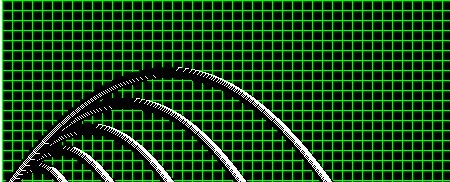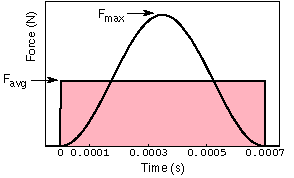Force on a Baseball
http://www.gmi.edu/~drussell/bats-new/impulse.htm
From the contact forces, we can see that the ball in the above picture actually becomes distorted.
Forces on a baseball vary from many different perspectives. They can be examined from the point of contact on the bat, the forces that act on it through the air that we have already studied, until the time that it lands on the surface of the earth. Primarily, we will observe the forces that act on the ball when it contacts the bat. During this sudden moment in time, a baseball experiences the most dramatic forces in its lifetime. We will consider what forces are necessary to propel a baseball a distance of 500 feet.
http://library.thinkquest.org/11902/physics/range.html
In order to calculate the forces during the moment the ball is in contact with the bat, a few specific things must be known. According to Isaac Newton's 2nd law of motion the force is equal to the mass times the acceleration or written as F = ma. Another valuable equation to use for this situation is a = (Vf - Vi)/T, where "a" is the acceleration, "Vf" is the final velocity, "Vi" is the initial velocity, and "T" is the change in time or time interval between the initial and final velocities. Substituting "a" into F = ma, we get the equation F = m(Vf - Vi)/T. Now all we need to know is the velocity of the pitch, rebound velocity, mass of the baseball, and the time it was in contact with the bat, which correspond to the variables, "Vi", "Vf", "m", and "T' respectively (Elert 2000).
http://www.gmi.edu/~drussell/bats-new/impulse.htm
Commonly, when a baseball is hit anywhere near 500 feet, the initial pitch speed is high, usually averaging 95 mph. The rebound velocity which we already calculated with air resistance is 152 mph. The mass of a baseball is 0.14 kilograms, and the contact time of the bat with the ball varies, but is often around 0.003 seconds. Since we are calculating the force in Newtons, a common unit of force, we must convert the velocities to meters per second. With this note, our initial velocity is -42.7 m/s, and our final velocity is 68 m/s. The initial velocity is negative because the positive direction is away from the hitter (Elert 2000).
Plugging these numbers into our equation: F = [(0.14kg)(68m/s - (-42.7m/s))]/0.003s, we find that the average force needed to hit a baseball 500 feet would be 5166 Newtons!!


